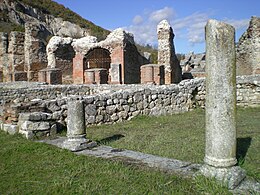Amiternum was an ancient Sabine city, then Roman city and later bishopric and Latin Catholic titular see in the central Abruzzo region of modern Italy, located 9 km (5.6 mi) from L'Aquila. Amiternum was the birthplace of the historian Sallust (86 BC).[1]
 | |
|
Shown within Abruzzo | |
| Location | L'Aquila, Province of L'Aquila, Abruzzo, Italy |
|---|---|
| Region | Abruzzo |
| Type | Settlement |
| History | |
| Periods | Roman Republic - Byzantine Empire |
| Cultures | Ancient Rome |
| Site notes | |
| Management | Soprintendenza per i Beni Archeologici dell'Abruzzo |
| Website | Area Archeologica Amiternum (in Italian) |
The site, in the upper Aterno valley, was one of the most important of Sabinum.[1]
Amiternum was defeated by the Romans in 293 BC.
It lay at the point of junction of four roads: the Via Caecilia, the Via Claudia Nova and two branches of the Via Salaria.[2]
There are considerable remains of an amphitheatre and a theatre, all of which belong to the imperial period, while on the hill of the surrounding village of San Vittorino there are some Christian catacombs.[2][1]
A well known Roman funerary relief of the first century BC depicts the Roman funeral procession or pompa.[3]
The modern name of the locality, San Vittorino, recalls the martyr Victorinus, who is looked on as the first bishop of Amiternum, allegedly of the time of the persecution by Roman Emperor Nerva (AD 30-98), although other sources put the bishopric's foundation in ca. AD 300. Around AD 400 it gained territory from the suppressed Diocese of Pitinum.
Other bishops of Amiternum include Quodvultdeus, who encouraged the religious veneration of Victorinus by constructing his tomb, Castorius, who is mentioned by Pope Gregory I, Saint Cetteus, martyred by the Lombards in 597, and Leontius, a brother of Pope Stephen II. The last known bishop is Ludovicus, who took part in a synod held in Rome in 1069.
Circa AD 1060, the bishopric was suppressed and its territory merged into the Rieti. In the mid-13th century the population was transferred to the newly founded town of L'Aquila, which was erected as a diocese by Pope Alexander IV on 20 February 1257, and incorporated the territory of the diocese of Amiternum.[4][5][6]
No longer a residential bishopric, the name Amiternum has been used by the Catholic Church since 1966 as a [7] Latin titular bishopric.
It has had the following incumbents:
Attribution:
42°24′02.00″N 13°18′21.60″E / 42.4005556°N 13.3060000°E / 42.4005556; 13.3060000